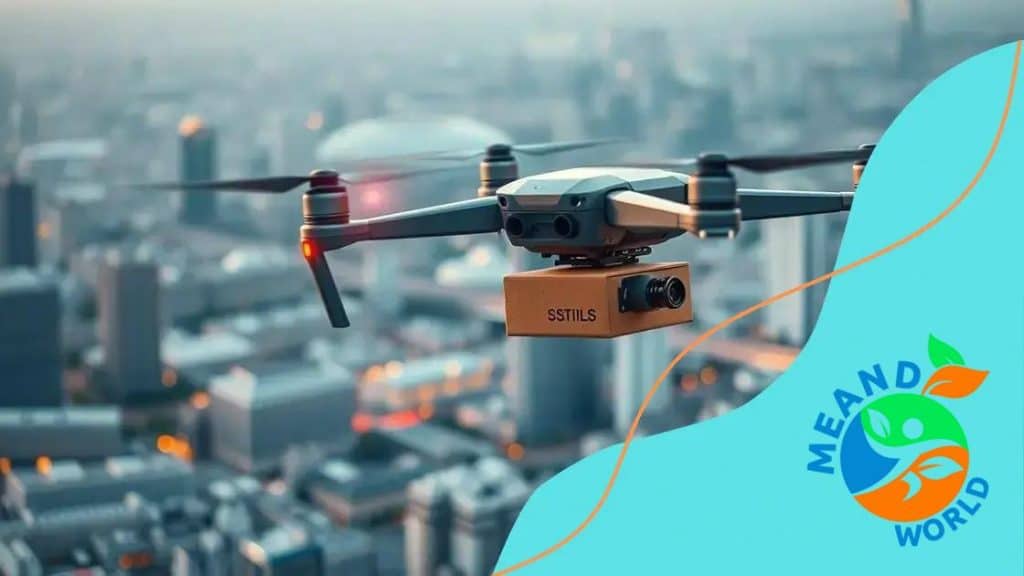How drones are reshaping logistics and delivery services

Anúncios
Drones are reshaping logistics and delivery services by providing faster delivery times, reduced costs, and improved access to remote areas, despite challenges like regulations and technical limitations.
How drones are reshaping logistics and delivery services is a topic gaining momentum as businesses seek innovative solutions. Have you considered how these flying devices are changing the way we receive goods? Let’s dive into this fascinating shift.
Anúncios
Understanding drone technology in logistics
Understanding drone technology in logistics is essential for grasping how this innovation is shifting the industry. Drones are becoming a vital component in supply chains, using advanced systems to deliver goods efficiently. As they gain popularity, many are curious about how they will influence delivery times and costs.
Anúncios
Key Features of Drone Technology
Drones rely on several key features that make them efficient in logistics. These include:
- Aerial Navigation: Drones use GPS and sensors to navigate through the air.
- Load Capacity: Most drones can carry small packages, making them ideal for local deliveries.
- Real-time Tracking: Users can monitor their deliveries in real-time, ensuring transparency.
- Autonomous Flight: Some drones can operate without human intervention, reducing labor costs.
Another important aspect of drone technology is its ability to operate in various environments. Manufacturers are designing drones that can withstand different weather conditions, allowing for deliveries in rain, snow, or even fog. The versatility of these machines opens new doors for logistics.
Benefits of Using Drones in Logistics
Utilizing drones has numerous benefits. Firstly, they minimize delivery times significantly. By flying over traffic and other obstacles, drones can deliver packages faster than traditional vehicles. This advance is especially crucial for urgent deliveries.
Additionally, drones can reduce operational costs. Unlike delivery trucks, drones require less fuel and maintenance, leading to savings for companies. But the advantages don’t stop there; drones also have the potential to reach remote areas that are difficult for standard vehicles to access, ensuring that everyone can receive their goods.
In summary, understanding the technology behind drones allows us to see their transformative impact on logistics. Combining aerial navigation, autonomous flight, and real-time tracking makes them an efficient choice for modern delivery services.
Impact of drones on last-mile delivery
The impact of drones on last-mile delivery is significant, offering a fresh solution to common logistical challenges. As online shopping continues to rise, meeting customer expectations for quick delivery has become crucial. Drones are stepping in to fulfill this demand, changing the landscape of delivery services.
Advantages of Drones in Last-Mile Delivery
The use of drones in last-mile delivery brings several advantages:
- Speed: Drones can often deliver packages faster than traditional vehicles, bypassing traffic and other ground-level obstacles.
- Cost-Effectiveness: Operating costs can be lower for drones, as they require less fuel and maintenance compared to delivery vans.
- Accessibility: Drones can reach remote areas that are typically hard to service, ensuring that even rural customers receive their orders quickly.
- Environmentally Friendly: Drones produce less pollution than traditional delivery vehicles, making them a greener option.
Furthermore, the implementation of drones allows for a more flexible delivery schedule. Companies can adjust delivery times based on demand, ensuring that products are delivered when customers want them. The flexibility provided by drones is a game-changer in the industry, as it enables businesses to cater to customer preferences more effectively.
Challenges Drones Face in Last-Mile Delivery
Despite their advantages, using drones for last-mile delivery is not without its challenges. Regulatory hurdles are significant, as safety and air traffic management are concerns that need addressing. Companies must navigate complex regulations to ensure compliance.
Additionally, technical limitations such as battery life and payload capacity pose difficulties. Drones can only carry small packages over short distances, which limits their usage for certain products. However, ongoing advancements in drone technology continue to enhance their efficiency and capabilities.
Overall, the integration of drones into last-mile delivery is reshaping the logistics landscape, making it faster, more efficient, and often more cost-effective.
Cost benefits of using drones

The cost benefits of using drones in logistics are becoming increasingly clear to businesses. By optimizing delivery methods, companies can significantly reduce their expenses. Drones offer a cost-effective solution that speeds up the delivery process while minimizing operational costs.
Reduced Operational Costs
One of the primary advantages of drones is their lower operational costs compared to traditional delivery vehicles. Here are some ways drones save money:
- Less Fuel Consumption: Drones are electric and consume less energy than fuel-powered trucks.
- Lower Maintenance Costs: Drones require less frequent maintenance, leading to reduced downtime.
- Decreased Labor Costs: With the ability to automate deliveries, companies can reduce the number of drivers needed.
- Efficient Route Management: Drones navigate directly to their destinations, cutting down on travel time and expenses.
These factors contribute to overall savings, enabling companies to allocate resources more effectively. Moreover, businesses can pass on some of these savings to their customers, creating a competitive edge in the market.
Scalability with Drones
Using drones also allows for greater scalability in operations. Companies can easily increase their delivery capacity without the corresponding increase in overhead costs. As demand rises, drones can be deployed to handle more deliveries without needing to invest heavily in vehicles or infrastructure.
As technology advances, the costs associated with drones are expected to decline further. This trend means that even small businesses can take advantage of drone delivery without a massive initial investment. The accessibility of drone technology is leveling the playing field, allowing more companies to compete effectively.
In summary, the cost benefits of using drones extend beyond immediate savings. They include long-term advantages such as scalability, improved customer satisfaction, and reduced environmental impact. Integrating drones into logistics is a forward-thinking strategy that can lead to considerable financial gains.
Challenges faced in drone delivery
The challenges faced in drone delivery are crucial to address as this technology continues to develop. While drones offer numerous benefits, there are also significant obstacles that companies must overcome to effectively integrate them into their logistics operations.
Regulatory Hurdles
One of the major challenges is navigating the complex regulatory landscape. Governments around the world have strict rules governing airspace and drone usage. Compliance with these regulations can be time-consuming and costly. Companies must obtain licenses and permits that ensure safety and security.
Moreover, air traffic management systems are not currently designed to accommodate a high volume of drone traffic, leading to potential airspace conflicts. Developing clear guidelines for drone operations is essential for the industry to grow.
Technical Limitations
Technical limitations also pose a hurdle for drone delivery systems. Although technology is advancing, drones still have some functional challenges. For example, battery life restricts the distance and duration that drones can operate. Most drones can only fly short distances before needing to recharge, which limits their delivery capabilities.
Payload capacity is another concern. Drones can typically carry only small packages, making them less suitable for larger deliveries. As a result, companies must carefully select the size and weight of packages for drone delivery.
Public Perception and Privacy Concerns
Public perception and privacy are additional challenges that must be managed. Many people are concerned about safety and security related to drones flying overhead. Questions about the potential for accidents or violations of privacy can lead to public resistance against drone delivery systems.
Building trust requires companies to prioritize safety measures and engage with local communities about the benefits and implementation of drone technology. Transparency will be key to overcoming concerns and gaining acceptance.
In summary, while challenges exist, the continued evolution of drone technology promises solutions to these obstacles. By addressing regulatory, technical, and public perception issues, the logistics industry can leverage the advantages that drones offer.
Future trends in drone logistics
Future trends in drone logistics are shaping the next phase of delivery systems. As technology advances, we can expect a significant transformation in how goods are transported. Drones are at the forefront of this change, offering innovative solutions for various logistical challenges.
Increased Automation
One key trend is the increased automation of delivery processes. Many companies are investing in automated drone systems that require minimal human intervention. This innovation will enhance efficiency and reduce labor costs, allowing businesses to streamline operations.
Automated drones will handle scheduling, routing, and even maintenance. This shift towards automation opens up opportunities for businesses to operate 24/7, providing faster service to customers.
Advanced Technology Integration
Integration of advanced technologies, such as artificial intelligence (AI) and machine learning, will also play a vital role in the future of drone logistics. Drones equipped with AI can analyze data in real-time to optimize delivery routes and improve performance.
Additionally, the use of machine learning algorithms enables drones to learn from past deliveries, making them more efficient over time. This evolution will lead to quicker and more reliable delivery services, ultimately enhancing customer satisfaction.
Enhanced Safety Features
Safety will remain a top priority as drone logistics grow. Future drone technology is expected to incorporate enhanced safety features to prevent accidents and ensure secure operations. Features like collision avoidance systems and advanced navigation tools will become standard.
As safety measures improve, public acceptance of drone deliveries will likely increase, leading to wider adoption across different sectors.
Last-Mile Delivery Innovations
Lastly, innovative solutions for last-mile delivery will emerge. Companies will develop more specialized drones, designed for urban environments and capable of navigating complex landscapes. This innovation will enable better access to hard-to-reach areas, ensuring that deliveries are made efficiently.
In summary, future trends in drone logistics promise a more automated, efficient, and safe delivery process. As advancements continue, the logistics industry will experience a profound change, benefiting businesses and customers alike.
FAQ – Frequently Asked Questions about Drones in Logistics
What are the main benefits of using drones for delivery?
Drones provide faster delivery times, lower operational costs, and improved accessibility to hard-to-reach areas.
How do regulations impact drone delivery services?
Regulations can impose restrictions on airspace usage, requiring companies to obtain permits and comply with safety guidelines.
What technological advancements are being integrated into drone logistics?
Drones are increasingly utilizing AI and automation to optimize navigation, delivery efficiency, and overall performance.
What challenges do companies face when implementing drone delivery?
Challenges include regulatory compliance, technical limitations such as battery life, and public perception regarding safety.





